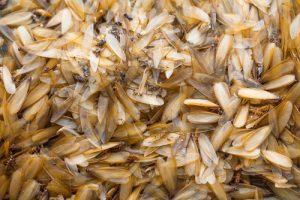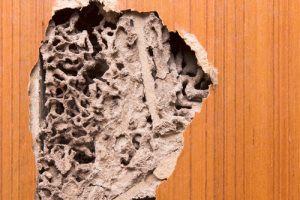What Do Termites Eat?
By Chris Williams on February 9, 2012.
Subterranean termites eat wood and other materials that contain cellulose. In the forest termites are primary decomposers. Termites feed on dead trees, fallen limbs, and stumps. Termites are able to return nutrients from the cellulosic materials to the soil and atmosphere. Without the work of termites and other agents of decay like fungi, beetles, sowbugs, ants, and millipedes, the surface of the earth would be littered with downed trees and debris. By working to break down this mass of wood termites and their ilk clear the way for new growth, and recycle the nutrients within the old trees.
 Termites are able to digest cellulose with the help of a symbiotic protozoan that lives within the hindgut. These protozoa, known as mastigophoran flagellates(in principle pest families of termites found in North America, Rhinotermitidae and Kalotermitidae) have evolved with the termites throughout their evolution. Newly hatched termites do not poses the protozoa, and must obtain them from an older termite. The process by which this is accomplished is called proctodeal feeding. Proctodeal feeding involves taking a small amount of liquid intestinal content from the anal opening of an older termite. During the molting process, a termite’s skin is shed as well as the hindgut lining. Molting results in a loss of the protozoa as well, and requires the termites to replenish the hindgut through proctodeal feeding. This is termed “refaunation”.
Termites are able to digest cellulose with the help of a symbiotic protozoan that lives within the hindgut. These protozoa, known as mastigophoran flagellates(in principle pest families of termites found in North America, Rhinotermitidae and Kalotermitidae) have evolved with the termites throughout their evolution. Newly hatched termites do not poses the protozoa, and must obtain them from an older termite. The process by which this is accomplished is called proctodeal feeding. Proctodeal feeding involves taking a small amount of liquid intestinal content from the anal opening of an older termite. During the molting process, a termite’s skin is shed as well as the hindgut lining. Molting results in a loss of the protozoa as well, and requires the termites to replenish the hindgut through proctodeal feeding. This is termed “refaunation”.
Termites are highly social insects that live together as a colony. Colonies start when winged reproductive, or allates, leave the nest in what is called swarming. Swarming takes place in spring to early summer, on warm days following a rain. Worker termites sense the environment for the right conditions and when the time is right, the swarm leaves the nest. Allates, male and female termites, leave the nest and pair up. Once paired the wings are shed, and the royal couple finds a suitable place in or near a food source(bark mulch, stumps, wood piles, etc…). Mating quickly takes place and the queen termite begins to lay eggs. Egg laying is slow at first, but increases with time. More workers are born and begin to find more food. It generally takes between 4 and 6 years for a termites colony to reach maturity and produce a swarm.
As the colony grows, a nest is made below the surface of the soil. A subterranean termite nest is like a big ball of hardened soil, made from a mixture of soil, termite feces, and saliva. A labyrinth of underground chambers and tubes make up the nest proper. Foraging tunnels extend out in all directions from the nest. Termites forage just below the surface of the soil, locating food through contact and other cues. Certain fungi and molds in decaying wood create chemicals that attract termite workers. As workers forage, they are able to use the earth’s magnetic field to navigate around the colony, they also have a strong sense of gravity. Sometimes workers within a structural piece of wood, such as a beam, will create working tunnels that extend straight down to the soil from above called suspended or drop tubes. Drop tubes form a more direct route back to the colony to speed up feeding, and are quite astonishing to view.
 Eastern subterranean termite colonies require about 1 cubic foot of wood per year, or more, depending on the size of the colony. Although many food sources contribute to this, if the termites are solely feeding on a structure, damage can become quite severe over time. Because of termites cryptic lifestyle they often go unnoticed until damage or a swarm is noted. Typical indications of termite activity within a structure include: swarming events, the presence of mud tunnels or tubes coming up the exterior or interior foundation walls, visible swarm slits in wood members, and soil where it should not be. If you think that termites are attacking your house, call a Pest Control Professional as soon as possible!
Eastern subterranean termite colonies require about 1 cubic foot of wood per year, or more, depending on the size of the colony. Although many food sources contribute to this, if the termites are solely feeding on a structure, damage can become quite severe over time. Because of termites cryptic lifestyle they often go unnoticed until damage or a swarm is noted. Typical indications of termite activity within a structure include: swarming events, the presence of mud tunnels or tubes coming up the exterior or interior foundation walls, visible swarm slits in wood members, and soil where it should not be. If you think that termites are attacking your house, call a Pest Control Professional as soon as possible!